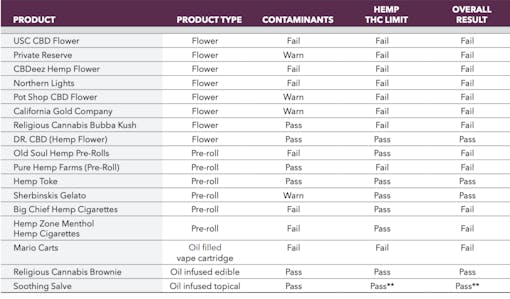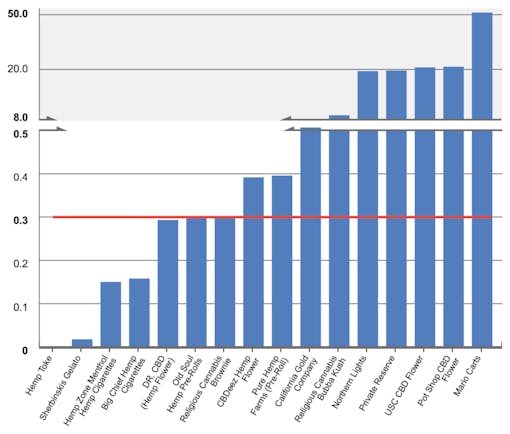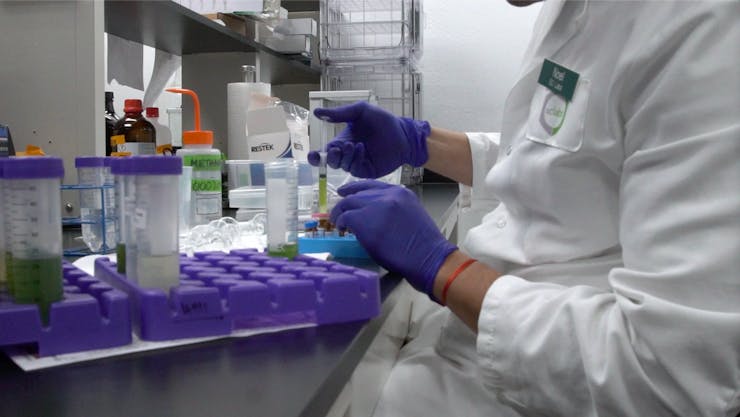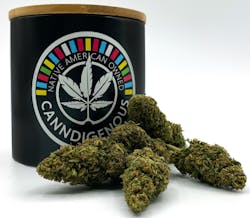This article was contributed by SC Labs, a Leafly Certified Labs partner.
Testing failures highlight the need for national regulations on hemp
As federal and state governments tackle the legalization of hemp as a distinct product from cannabis, the safety of the products produced from hemp isn’t getting the same attention as those produced from THC-based cannabis. While every crop requires a cannabinoid test to establish its identity as hemp rather than marijuana, the federal government and all but a handful of states have been silent.
In response to the 2018 farm bill, the USDA and the DEA have weighed in with interim rules establishing a system for the production of massive amounts of hemp-derived CBD and other cannabinoids. This year will be a record crop and all the cannabinoids derived from the hemp will pour into innumerable products, many of which will be marketed as medicines, yet the FDA has yet to propose any safety requirements for those products.
However, a handful of states have regulations on the books that will require some testing of hemp-based CBD products. Notably absent is California, where a bill that would have regulated hemp like other cannabis products failed during the previous legislative session.
In an effort to survey the contaminants present in hemp-derived products as well as the accuracy of labeling for active ingredients, SC Labs and the United Cannabis Business Alliance (UCBA) partnered to test products purchased at unlicensed CBD retailers and traditional ‘smoke shops’ in the Los Angeles area. The results were concerning. Over 70% of the samples failed for either excessive levels of contamination or contained too much THC to qualify as hemp or both when tested against California standards for inhalable cannabis products.
Summary

Source: SC Labs™ Analysis Report: CBD and Hemp-Derived Products
Many samples purchased from CBD shops and smoke shops—and labeled as hemp—were actually high-THC cannabis products.
The testing suggests that unregulated, and dirty, cannabis from unknown sources is reaching store shelves labeled as hemp, posing a serious safety risk to consumers. A majority of samples labeled and sold as hemp contained levels of THC many times over the legal limit sufficient to cause psychoactive effects and intoxication, which could be frightening or even dangerous for an unsuspecting CBD consumer. Furthermore, 42% of the samples tested exceeded California’s legal limits for pesticide and heavy metal contaminants set for regulated cannabis.

**Sample passed Hemp THC limit but likely not hemp-derived
Source: SC Labs™ Analysis Report: CBD and Hemp-Derived Products
A large degree of consumer safety has been built into the regulated adult-use cannabis market, which is getting more refined as states legalize one-by-one. In most places where they are legal, THC-based cannabis products have standards of purity and testing requirements comparable to pharmaceutical products, and as such, there haven’t been major scandals with regards to unsafe cannabis products being sold on the legal market. Product purity has even become a differentiator for high-end brands in the cannabis industry.
However, whether it be adulterated or contaminated vape cartridges, or dangerous levels of pesticides used by unscrupulous growers, unregulated and illicit cannabis products haven’t had the same track record in terms of safety. The most tragic example of this is the series of severe illnesses and deaths linked to the use of Vitamin E Acetate as a cutting agent in illicit vape cartridges.
Consumers of hemp-derived CBD products may assume they can expect the same accuracy in dosage and levels of purity as products sold in the regulated cannabis market, but this is not the case. While many hemp-derived CBD producers voluntarily adhere to quality standards, the results of this survey suggest some potentially dangerous products are still making it to store shelves.
High levels of contamination
Of the samples that failed for contamination at levels in excess of those allowed in cannabis products in California, many failed for multiple pesticide and heavy metal contaminants at alarmingly-high concentrations. One vape cartridge contained 17 pesticides in concentrations up to several hundred times more than the state’s action limit for cannabis products. Furthermore, the cartridge contained at least 6.5 ppm of lead – over 13 times the legal limit. These levels are indicative of gross contamination of the extraction and/or packaging equipment. If so, each batch produced on the shared equipment would likely be similarly contaminated.
The vape cartridge was not the only sample found to be grossly contaminated. One flower and several pre-rolled samples (three of six) contained failing levels of heavy metals. Three out of four of those samples failed for multiple metals. When comparing the unregulated CBD samples with the regulated cannabis market, the frequency of failed heavy metals testing in flower and pre-roll products and the occurrences of multiple failures per product sample in the CBD samples were anomalous when compared to the regulated cannabis market. In total, seven out of seventeen samples failed the required safety testing, including five failures for heavy metals and three for pesticide contamination.
Cannabis sold as hemp
Perhaps the most unexpected results of the study were that so many of the samples purchased from the CBD shops and smoke shops labeled as hemp were actually just traditional high-THC cannabis products. 53% of the samples, all labeled as hemp or hemp-based, did not qualify, by definition, as hemp. The 2018 farm bill classifies hemp as cannabis that contains no more than 0.3% total THC.
Total THC content in CBD products

Nine of the seventeen samples, based on THC concentration, would be classified as cannabis rather than hemp, the majority of which contained little CBD and significant levels of THC. Five of the flower samples, the vape cartridge, and the edible product all contained levels of THC sufficient to give an unsuspecting user a significant psychoactive experience. The topical product also contained mostly THC and very little CBD, indicating it was cannabis and not hemp-derived. Since the edible had a low overall concentration of cannabinoids, it didn’t cross the 0.3% technical threshold but was clearly not hemp-derived either, essentially circumventing the cannabis regulations.






